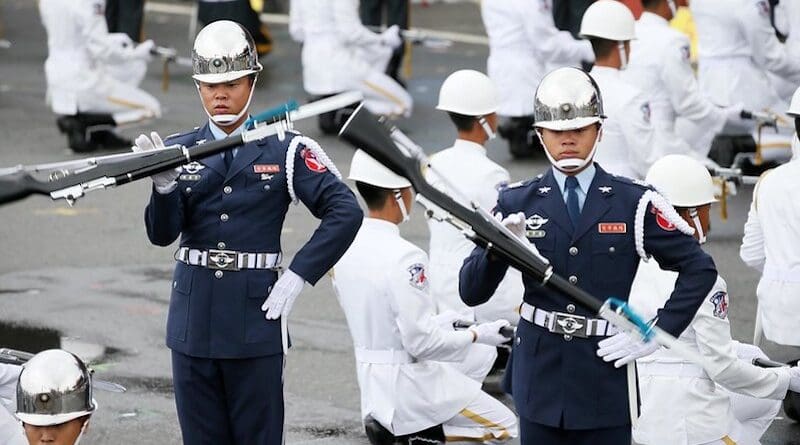Taiwan’s Indigenous Solutions For National Defence – Analysis
By Joshua Bowes and Caleb Mills
On 14 March 2024, scientists and reporters from around the world gathered at the National Chung-Shan Institute of Science and Technology (NCSIST) to observe the next expansion in Taiwan’s evolving military arsenal. Those present witnessed the beginning of a new era in defence strategy as the growing threat of invasion nudges Taipei towards high-tech armaments and weapons systems to address Beijing’s military intensification.
It is not just Taiwan’s accelerated stockpiling of weapons that has caught the attention of international observers. It is also the type of weapons Taiwan has chosen to develop that has sent a stark message. This technological refocus reflects Taiwan’s shifting perspective on a potential conflict with China, commentators suggest, with the ultimate goal being self-sufficiency.
The weapons revealed in early March demonstrate this shift. Unmanned aerial vehicles like the Albatross II and Cardinal III are designed to track naval and land movements using advanced AI targeting and can stay airborne for up to 16 hours. Taiwan also recently implemented a new anti-drone weapon into its armed forces in late February 2024, part of a US$146 million program aimed at strengthening defence capabilities across the island’s 40 military bases.
These investments likely target China’s frequent deployment of spy drones near Taiwanese waters. Beijing has previously been accused of using drones to experiment with electromagnetic warfare and conduct intelligence operations, heightening regional security concerns.
Taiwan’s first self-made submarine, the Narwhal, is slated for final tests this year and will further enhance maritime capabilities that help foster ‘asymmetric warfare strategies’, according to outgoing Taiwanese President Tsai Ing-wen.
This sentiment was also expressed by researchers at NCSIST and is evident in the Narwhal’s operational limitations. The Taiwan Strait is not deep enough for submarine deployment in the event of a naval engagement with China, but Taiwan’s military has hinted that submarines may help limit Chinese maritime movements through the Bashi Channel instead. Control of this channel could dictate access to the broader Pacific in a contingency with China.
Taipei aims to build eight Narwhal vessels. The US$1.5 billion submarines are equipped with high-tech combat systems, including multiple torpedo apparatuses supplied by Lockheed Martin. NCSIST has also reportedly begun work on a 50-kilowatt high-energy laser weaponthat closely resembles the US Army’s DE M-SHORAD system. China is also developing such weaponry, reinforcing the escalation in the utilisation of emergent technologies for modern armaments.
Taiwan’s embrace of indigenous weapons has so far failed to impact its dependence on US arms imports. On 22 February 2024, Taiwan received its latest delivery of arms from the United States, totalling US$75 million, marking its 13th sale of weapons under the Biden administration. The deal included the provision of NATO’s Link 22 data system, establishing a direct link of communication with the United States and making it possible to interconnect air, surface, sub-surface and ground-based tactical operations. Beijing condemned the sale and sanctioned a handful of defence contractors in retaliation.
US military authorities repeatedly warn that China is preparing to invade Taiwan as early as 2027 and reconnaissance missions seem to support this. In late March 2024, satellite imagesappeared to show the People’s Liberation Army (PLA) conducting simulated attacks on Taiwanese infrastructure. In 2023, the Pentagon produced a report on China’s continued efforts to assert its military power in the Indo-Pacific, reporting dozens of unsafe intercepts carried out by PLA aircraft and marine vessels in the South China Sea.
Taiwan’s prioritisation of indigenous weapons manufacturing, combined with its shift towards an asymmetrical defence strategy, signals the next stage of its struggle against mainland China. But it does not alleviate the severe disadvantages with which Taipei must grapple in the event of a conventional conflict.
China’s military boasts around two million active-duty personnel, compared to Taiwan’s 170,000. China’s navy is more than three times the size of Taiwan’s and its air force more than double. Even if Taiwan was able to match China’s traditional strengths on the battlefield, the price it could pay might be the civil liberties and political freedom it cherishes. Considering Taiwan’s history with dictatorship, the potential risk for democracy that accompanies military build-up should not be taken lightly.
The most innovative blueprints for defence cannot negate simple math. When measured by conventional metrics, Taiwan continues to be outgunned and outmanned. Taipei’s evolving strategy is a step in the right direction, but the outlook for a possible arms race with Beijing remains grim at best.
As tensions flare in the South China Sea, it seems that Beijing remains committed to the so-called liberation of Taiwan. The PLA’s relentless intimidation and harassment tactics emphasise the need to meet China’s techno-nationalist aggression head-on. Still, attempts at de-escalation remain the norm for Taiwan’s allies. US President Joe Biden affirmed Washington’s ‘One China’ policy to Chinese President Xi Jinping in their most recent phone call, underscoring strong opposition to any military aggression against Taiwan.
While Xi held firm on China’s intolerance for Taiwanese ‘separatist’ activities, Biden’s reinforcement of military deterrence is a stern reminder that peace is invaluable and the ascendancy of democracy is imperative.
About the authors:
- Joshua Bowes is a Research Associate at The Millennium Project’s South Asia Foresight Network.
- Caleb Mills is a Research Assistant at Purdue University studying International Relations.
Source: This article was published at East Asia Forum

